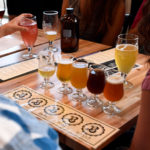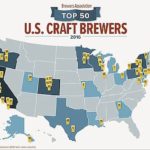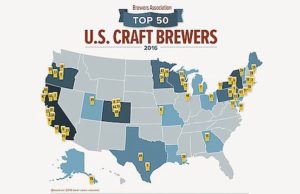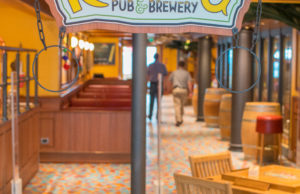Water, malt, hops, yeast
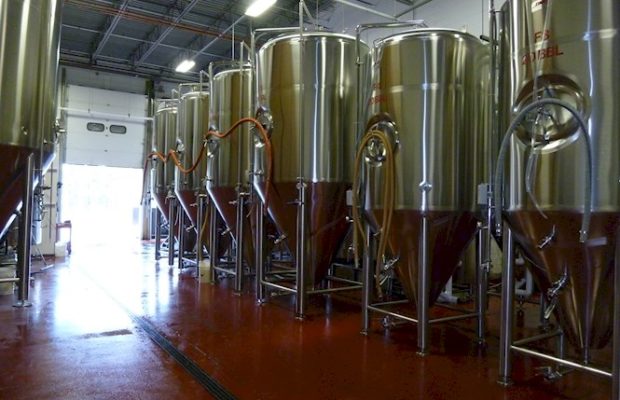
The brewing industry has undergone a craft revolution, leading to ane explosion of new brands and new beers. Do young breweries and small brewers understand the power of brand? Brittany Golob examines packagaing, reputation and the ultimate value of brand in the craft brewing industry
Most beers are comprised of just four ingredients. Yet, there are over 30,000 brands of beer in the world. That number has risen in the past few years due largely to the increased growth and popularity of craft beer.
In the US alone, craft beer has recorded eight years of double digit increase in volume and has doubled its market share to 12%, from 5.7% in 2011. But the value of the craft beer industry extends beyond the bottom line. Brand value is being built into craft beer brands and brewers as they are developed. The global standard bearers are well known even by non-initiates to the world of craft beer.
Brooklyn Lager has taken over New York and its Milton Glaser-designed brand was just updated by the man himself. Sierra Nevada is the second-best selling craft beer in the US after Samuel Adams – the latter is now a household name. Britain’s BrewDog and Meantime breweries are making waves internationally as well, particularly since the latter was acquired by SABMiller last year.
But the thousands of craft brands now in existence have to compete not only with these giants of the craft scene, but also with the traditional international brewers more commonly seen in bars and pubs the world over. Meeting that challenge requires a combination of design acumen, brand strategy, reputation management and, most importantly, a great-tasting beer.
“Craft beer has been fuelled by the demographic change and the way people are socialising. The result of that is the way that these brands are having to use brand and are having to use design, is that they are having to shout ever louder. It is like an arms race. That is why you get the diversity of design. It is why you get the diversity of names, of strange flavours, because there is so much choice,” Mark Cullen, strategist and planner at British brand agency Good says.
For some breweries, the approach to design emphasises its location or local heritage. For others, it’s about standing out in a bold, artistic way. And for others still, personality is writ large, but design cues are taken from the major players as a means of competing on a wider scale.
The Hong Kong Brewing Company, the first craft brewery on Hong Kong island, was reinvigorated in 2013, when Devin Kimble and Daniel Flores acquired it. They kept the name, but that was about it. The beer recipe was redeveloped and the packaging redesigned. Now, the names of the beers reflect Chinese or Cantonese cultural touchpoints and use both English and Cantonese script. Kimble says the design had to have recognisable design cues for beer drinkers and evoke the brand’s status in the region.
China, he says, is a mixed market of experienced craft drinkers – a group comprised of western expats and Chinese people who have worked or studied abroad – and new customers unfamiliar with craft beer or with beer in general.
Thus, the professional, yet beautifully-rendered bottles allow the Hong Kong Brewing Company to stand out in bar fridges, hotels and increasingly, among competitors outside of the region.
Others go down the more artistic route. Remote state capital Juneau’s only brewery, Alaskan Brewing Company, is quickly spreading across the US and is known internationally for its unique smoked porter. The brand focuses on the Alaskan wordmark placed alongside the illustrated labels for seasonal brews.
Andy Kline, communications manager at Alaskan says, “We are a brand that represents not just a location, but all of the associations people have about that location. So our labels need to convey history, beauty, purity and quality. And our bottles need to have a look and feel that is rooted in history.” He says place is a strong part of the way Alaskan differentiates itself in a crowded market. “Our design is about telling the story of this amazing place where we brew and live. So from the fishing vessels to the amazing wildlife and adventurers used in our designs, we are bringing a part of Alaska to our drinkers, and that in turn gives them a more fulfilling drinking experience.”The brewery recently hired a local artist to develop its range. Everything from polar bears to fishing boats to orca and caribou adorn the otherwise single-colour labels. Strongly linking a place to a brewery is one of the key strategies craft brewers pursue when developing a brand, Cullen points out.
This is also true for British breweries, many of which have been producing craft beer for decades. Skinner’s, a relative newcomer having been established in 1997, is based in Truro, Cornwall and uses local Cornish folklore to inform the names and packaging of its beers. It just rebranded by selecting different artists for each of its products, Skinner’s has more closely tied its brewery to the Cornish coast.
Mike Pritchard, the commercial director at Skinner’s, says the brewery didn’t want its rebrand to strip the individuality and local ties from the brand. Research into the audience for each ale allowed Skinner’s to pick the artist best suited to each product. “It’s one of the reasons our flagship ale, Betty Stogs, was redesigned by Nick Beringer – the artist who has crafted the artwork for Betty from the very beginning. Using a different artist for each was intentional. Skinner’s has always reflected individuality and we wanted each of our ales to stand alone in its own right, but sit as part of the range and create a new brand style for Skinner’s.”The brewery recently hired a local artist to develop its range. Everything from polar bears to fishing boats to orca and caribou adorn the otherwise single-colour labels. Strongly linking a place to a brewery is one of the key strategies craft brewers pursue when developing a brand, Cullen points out.
This is also true for British breweries, many of which have been producing craft beer for decades. Skinner’s, a relative newcomer having been established in 1997, is based in Truro, Cornwall and uses local Cornish folklore to inform the names and packaging of its beers. It just rebranded by selecting different artists for each of its products, Skinner’s has more closely tied its brewery to the Cornish coast.
Mike Pritchard, the commercial director at Skinner’s, says the brewery didn’t want its rebrand to strip the individuality and local ties from the brand. Research into the audience for each ale allowed Skinner’s to pick the artist best suited to each product. “It’s one of the reasons our flagship ale, Betty Stogs, was redesigned by Nick Beringer – the artist who has crafted the artwork for Betty from the very beginning. Using a different artist for each was intentional. Skinner’s has always reflected individuality and we wanted each of our ales to stand alone in its own right, but sit as part of the range and create a new brand style for Skinner’s.”Scottish brewer BrewDog, which has developed something of a cult-like following, employs a similar strategy. Chief creative officer at BrewDog, Simon Shaw, says, “We want to empower international illustrators to interpret the weird and wonderful names and styles of our beers. Our small batch series challenges perceptions about beer. We want the cans to do the same.”
The physical touchpoints and visual identity are important in brewing. “The label, as well as the actual bottle is a vital part of the product that people are connecting with,” Kline says. The label design and format, bottle or can – craft is increasingly turning to cans rather than glass bottles – design and colour, bottle caps and the physical touchpoints found in pubs and bars convey the provenance and quality of the beer and generally, imbue the humble 7,000-year old drink with brand value.
Brand experts working with craft beer say the price range for beer is more limited than other alcohol. Wine can range from $2 to thousands, while whisky and vodka distillers have turned their products into luxury goods with unlimited brand value. For beer, brand value can make the difference both in consumer choice and in price. “It’s an affordable luxury,” Isaac Arthur of Codo Design, an Indianapolis-based brand agency that has developed a 20-chapter craft beer branding guide, says. “You can pay a couple bucks more to have something that’s well-packaged and branded.”
Cullen agrees saying that craft beer is becoming a lifestyle choice, causing consumers to buy into the brand rather than simply to purchase a product. But, he adds, that the next logical step is to increase the brand experience in drinking craft beer. Thus many brewers are developing their in-house bars or establishing chains of bars. “Suddenly, that becomes an experience,” Cullen says. “That’s where the provenance comes in and the personality comes in.”
Simon Gore, MD of London-based design agency Parker Williams says these brewer-owned bars are following the gastropub trend sparked in city centres worldwide. The experience of the bar can, “Open up the whole experience so people can walk in and almost take it out of the barrel themselves.” To get that experience right, brands have to have a strong sense of self. Arthur says one way to differentiate a branded experience and ensure it succeeds is to connect the brewery with the local community. But, he warns of brands trying only to to achieve results on par with BrewDog or Lagunitas. Arthur adds, “The best breweries that we’ve seen are people who started their breweries because they were obsessed with beer.”
A successful brewer has a strong brand, which, like any other product or sector, comes first from the internal culture, and then the beer itself and how the brand wants to be perceived. The boom in craft brewing has diluted this focus on brand so there are many new brewers that go little more than label-deep in terms of brand strategy.
“The really clever ones have built a brand that is going to be underpinned by values and behaviour and attitude and emotion. And by provenance and personality,” Cullen says. “The ones that get that right can just keep growing because they are selling an idea instead of a product.”
International growth and distribution is a matter of capacity for craft brewers. Bottling systems are expensive and bulky and may be prohibitive for small outfits. “Volume is the really big issue. Being able to sell enough beer is really important for overcoming what are pretty significant overhead costs,” says Kimble. “It can easily be $300,000 for an entry-level bottling system that’s of professional quality.” That perhaps accounts for the limited distribution in terms of both volume and geography for many craft brewers.
Thus one option for growth is to aim for acquisition by a major player like AB InBev, SABMiller or Kirin.
“I think identification of the brewery is sometimes more important than the type of beer,” Giles Calver, planning director of London creative agency Sedley Place, and self- confessed craft beer enthusiast, says. However, the stronger the brand, the more likely it will be to be picked up by a distributor or major company. “Brand value is what it’s all about,” Cullen says. “If you’re a craft beer maker, most of it will be in recall and reputation.” That’s what makes a pub- goer pick a craft beer from the cooler or the taps and what makes major brewing conglomerates consider acquisition of a local or regional brand.Brand value, in the case of acquisition accounts not only for consumers purchasing a $7 bottle of Brooklyn Lager rather than a $5 bottle of Budweiser but for a major company to spend millions on a craft brand. Meantime cost SABMiller £120m and at the time the craft brewer was panned for selling out to the corporate. Yet, Meantime has increased its production by 60% since 2013 and is available in more countries than it would have reached without the distribution capacity of SABMiller.
The risk the majors have in working with craft, however, is dilution of the brand. Craft is also about attitude. Calver points out a number of craft brewers that he knows of through their reputation and attitude alone. Being distributed by an international corporate may dilute the power of the brand a brewer worked so hard to build. However, if the aim is to translate brand value into commercial value, acquisition is a sensible option considering the high barriers facing small brewers in terms of distribution and packaging.
Beer is comprised of walter, malt, hops and yeast. But, the brand of a beer may be a more complex recipe.
Click here to view original web page at www.transformmagazine.net





